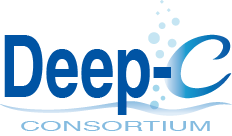Resources & Links
Fact Sheets
Deep-C has developed a number of easy-to-read fact sheets about our scientific research as well as some outreach initiatives that are available to the public:
Deep-C Scientific Research
 |
 |
|
 |
 |
|
 |
 |
Deep-C Outreach Initiatives
 |
 |
|
 |
||
General Information about the Gulf and the 2010 Oil Spill
National Geographic "Interactive Gulf Life" - ![]() The Gulf of Mexico's wealth of habitats make it one of the world's most ecologically and economically bodies of water. National Geographic Layers of Life features a "Gulf Life" tool that illustrates the ocean zones in the Gulf of Mexico. From Sand Fiddler Crabs in the coastal ecosystem to Tube Worms in the deep sea, this interactive graphic is just one of many tools with information about life in the Gulf and the 2010 oil spill.
The Gulf of Mexico's wealth of habitats make it one of the world's most ecologically and economically bodies of water. National Geographic Layers of Life features a "Gulf Life" tool that illustrates the ocean zones in the Gulf of Mexico. From Sand Fiddler Crabs in the coastal ecosystem to Tube Worms in the deep sea, this interactive graphic is just one of many tools with information about life in the Gulf and the 2010 oil spill.
Smithsonian Ocean Portal - The Smithsonian National Museum of Natural History, in partnership with scientists funded by the Gulf of Mexico Research Initiative (GoMRI), have developed an interactive infographic, The Anatomy of an Oil Spill: Science from the Gulf of Mexico, to visualize the oil spill and describe the research underway in the Gulf. Visitors can follow a story line from the beginning of the spill to the present, exploring the event and its impacts using information provided by GoMRI research findings.
Centers for Ocean Sciences Education Excellence (COSEE) - The extraction and transport of oil from near and off shore wells has been and will continue to be an environmental risk. Frequent small oil spills, urban run-off and naturally occurring oil seeps introduce oil into the ocean every day, however the Deepwater Horizon event during 2010 released unprecedented amounts of oil and chemical dispersants into the Gulf of Mexico. Scientists are still trying to assess the magnitude and impact of the event. Included on this website are several links to information and activities about oil, the extraction of oil, oil spills and the impact on the environment.
BP Gulf of Mexico Restoration - Information about how British Petroleum (BP) responded to the spill and ongoing efforts to restore the environment and economy.
Gulf of Mexico Research Initiative - The mission of the Gulf of Mexico Research Initiative (GoMRI) is to improve society's ability to understand and mitigate the impacts of hydrocarbon pollution and stressors of the marine environment, with an emphasis on conditions found in the Gulf of Mexico. In addition, the knowledge accrued will be applied not only to resolve but also to improve the long-term environmental health of the Gulf of Mexico.
OilSpillHub.org - Oilspillhub.org is an online resource for those studying the largest environmental disaster in U.S. history. The site provides an archive of the underwater video of the event, as well as additional tools and resources for educators, scientists, and engineers who are expanding our knowledge of environmental issues. The website was developed and is hosted by Purdue University working in cooperation with the U.S. Senate Committee on Environment and Public Works and the House Select Committee on Energy Independence and Global Warming and the Energy and Environment Subcommittee in the House Energy and Commerce Committee.
RestoretheGulf.gov - RestoretheGulf.gov is the official federal portal for the Deepwater BP oil spill response and recovery. This site provides the public with information on the response, current operations, news and updates, how to file a claim and obtain other assistance, and links to federal, state and local partners.
Deep-C Researcher Labs
The Huettel Lab at Florida State University - Research in the Huettel lab group focuses on the ecology of coastal and shelf environments with emphasis on processes in the sediments and at the sediment-water interface. Dr. Markus Huettel has 20 years experience in oceanographic research focusing on transport and reaction in shelf sediments. His interdisciplinary work approach, integrating biological, chemical, and physical processes, addresses the cycling of matter in the coastal ocean.
The Kostka Lab at GaTech - Dr. Joel Kostka serves on the steering committee and as a co-PI of the Deep-C consortium. In 2010, he served as co-PI on NSF Rapid and NSF Rapid MRI projects to study the impact of Deepwater Horizon crude oil on the biogeochemical processes in Florida sandy beaches. In 2011, Dr. Kostka coauthored a report from the American Academy of Microbiology entitled, “Microbes and Oil Spills: Frequently Asked Questions.”
The Reddy Lab at Woods Hole Oceanographic Institution - Dr. Chris Reddy, senior scientist in the Department of Marine Chemistry and Geochemistry at Woods Hole Oceanographic Institution, studies the fate and transport of the spilled oil following the Deepwater Horizon disaster. Specifically, Dr. Reddy's lab tries to determine what compounds found in the oil last the longest in the environment and why. He has extensive experience with the Deepwater Horizon.
Deep-C was a four-year, interdisciplinary study of deep sea to coast connectivity in the northeastern Gulf of Mexico.Deep-C is no longer an active research project. The information on this website is for historical reference purposes only.
Home | About Us | Research Areas | Data Center | News & Multimedia | Education & Outreach
© Deep-C Consortium. All Rights Reserved.
This research was made possible by a grant fromThe Gulf of Mexico Research Initiative (GoMRI).
Copyright | Disclaimer | Privacy Policy
